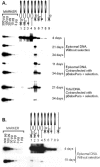Episomal maintenance of plasmids with hybrid origins in mouse cells
- PMID: 16306599
- PMCID: PMC1316011
- DOI: 10.1128/JVI.79.24.15277-15288.2005
Episomal maintenance of plasmids with hybrid origins in mouse cells
Abstract
Bovine papillomavirus type 1 (BPV1), Epstein-Barr virus (EBV), and human herpesvirus 8 genomes are stably maintained as episomes in dividing host cells during latent infection. The mitotic segregation/partitioning function of these episomes is dependent on single viral protein with specific DNA-binding activity and its multimeric binding sites in the viral genome. In this study we show that, in the presence of all essential viral trans factors, the segregation/partitioning elements from both BPV1 and EBV can provide the stable maintenance function to the mouse polyomavirus (PyV) core origin plasmids but fail to do so in the case of complete PyV origin. Our study is the first which follows BPV1 E2- and minichromosome maintenance element (MME)-dependent stable maintenance function with heterologous replication origins. In mouse fibroblast cell lines expressing PyV large T antigen (LT) and either BPV1 E2 or EBV EBNA1, the long-term episomal replication of plasmids carrying the PyV minimal origin together with the MME or family of repeats (FR) element can be monitored easily for 1 month under nonselective conditions. Our data demonstrate clearly that the PyV LT-dependent replication function and the segregation/partitioning function of the BPV1 or EBV are compatible in certain, but not all, configurations. The quantitative analysis indicates a loss rate of 6% per cell, doubling in the case of MME-dependent plasmids, and 13% in the case of FR-dependent plasmids in nonselective conditions. Our data clearly indicate that maintenance functions from different viruses are principally interexchangeable and can provide a segregation/partitioning function to different heterologous origins in a variety of cells.
Figures







Similar articles
-
Replication licensing of the EBV oriP minichromosome.Curr Top Microbiol Immunol. 2001;258:13-33. doi: 10.1007/978-3-642-56515-1_2. Curr Top Microbiol Immunol. 2001. PMID: 11443858 Review.
-
Long-term episomal maintenance of bovine papillomavirus type 1 plasmids is determined by attachment to host chromosomes, which Is mediated by the viral E2 protein and its binding sites.J Virol. 1999 May;73(5):4404-12. doi: 10.1128/JVI.73.5.4404-4412.1999. J Virol. 1999. PMID: 10196338 Free PMC article.
-
Cryo-EM Structure and Functional Studies of EBNA1 Binding to the Family of Repeats and Dyad Symmetry Elements of Epstein-Barr Virus oriP.J Virol. 2022 Sep 14;96(17):e0094922. doi: 10.1128/jvi.00949-22. Epub 2022 Aug 29. J Virol. 2022. PMID: 36037477 Free PMC article.
-
Replication of a chimeric origin containing elements from Epstein-Barr virus ori P and bovine papillomavirus minimal origin.Virus Res. 2001 May;75(1):1-11. doi: 10.1016/s0168-1702(01)00218-0. Virus Res. 2001. PMID: 11311423
-
Control of Viral Latency by Episome Maintenance Proteins.Trends Microbiol. 2020 Feb;28(2):150-162. doi: 10.1016/j.tim.2019.09.002. Epub 2019 Oct 14. Trends Microbiol. 2020. PMID: 31624007 Free PMC article. Review.
Cited by
-
Effective formation of the segregation-competent complex determines successful partitioning of the bovine papillomavirus genome during cell division.J Virol. 2010 Nov;84(21):11175-88. doi: 10.1128/JVI.01366-10. Epub 2010 Sep 1. J Virol. 2010. PMID: 20810736 Free PMC article.
-
Structural and functional analysis of rare missense mutations in human chorionic gonadotrophin β-subunit.Mol Hum Reprod. 2012 Aug;18(8):379-90. doi: 10.1093/molehr/gas018. Epub 2012 May 3. Mol Hum Reprod. 2012. PMID: 22554618 Free PMC article.
-
Analysis of viral cis elements conferring Kaposi's sarcoma-associated herpesvirus episome partitioning and maintenance.J Virol. 2007 Sep;81(18):9825-37. doi: 10.1128/JVI.00842-07. Epub 2007 Jul 11. J Virol. 2007. PMID: 17626102 Free PMC article.
-
Brd4 is involved in multiple processes of the bovine papillomavirus type 1 life cycle.J Virol. 2006 Apr;80(7):3660-5. doi: 10.1128/JVI.80.7.3660-3665.2006. J Virol. 2006. PMID: 16537635 Free PMC article.
-
The cytoprotective protein MANF promotes neuronal survival independently from its role as a GRP78 cofactor.J Biol Chem. 2021 Jan-Jun;296:100295. doi: 10.1016/j.jbc.2021.100295. Epub 2021 Jan 15. J Biol Chem. 2021. PMID: 33460650 Free PMC article.
References
-
- Ausubel, F. M., R. Brent, R. E. Kingston, D. D. Moore, J. G. Seidman, and K. Struhl (ed.). 1998. Current protocols in molecular biology. John Wiley & Sons, Inc., New York, N.Y.
-
- Ballestas, M. E., P. A. Chatis, and K. M. Kaye. 1999. Efficient persistence of extrachromosomal KSHV DNA mediated by latency-associated nuclear antigen. Science 284:641-644. - PubMed
Publication types
MeSH terms
LinkOut - more resources
Full Text Sources
Other Literature Sources
Miscellaneous

